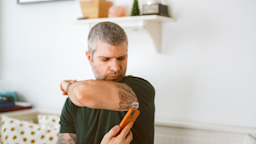Key takeaways:
Hemoglobin A1C (HbA1c or A1C) is a blood test that measures the average amount of glucose in your blood over the past 2 to 3 months.
An A1C test can help diagnose prediabetes or diabetes. It can also help people living with diabetes manage their condition.
In addition to having your A1C tested in a lab or at a doctor’s office, you can also use an FDA-approved, at-home test kit. These are all accurate ways to measure your A1C.
Hemoglobin A1C (HbA1c or A1C) testing is used to screen for prediabetes or diabetes. It’s also good for monitoring average glucose (blood sugar) levels in those already diagnosed with diabetes.
For years, the only way to measure your A1C level was with a blood draw at the lab or doctor’s office. But now you can test your A1C from the comfort of your own home. Here’s how at-home A1C testing works and how to decide whether it’s right for you.
What does A1C measure?
A1C testing tells you what your glucose has been, on average, over the past 2 to 3 months. It’s different from monitoring your blood sugar at home with a glucometer (glucose meter) or a continuous glucose monitor (CGM), which tell you what your glucose is at a specific moment.
How do at-home A1C test kits work?
At-home A1C kits allow you to skip the clinic visit and the laboratory when checking your hemoglobin A1C. There are a number of tests to choose from, and you can order them online or get them through a pharmacy. Availability often varies by state. The kits include specific instructions on how to collect the blood sample and return it.
Another option is to buy the A1CNOW Self Check, which is the only at-home A1C monitor currently available for purchase. It lets you get on-the-spot results in about 5 minutes, rather than mailing in the test for your results. It comes with four strips and works similarly to a glucometer.
How to check your A1C at home
Just like lab-based A1C testing, you don’t need to do any special preparation before testing your A1C. You can go ahead and eat and drink as usual.
The instructions may vary by test, so it’s important to read them carefully. But generally speaking, testing consists of a few basic steps:
Collect your blood sample via finger prick.
Follow the kit’s instructions on how to mail in the sample.
Get your results (turnaround time varies by test).
Some companies have clinical staff to discuss test results and next steps with you. If you have a primary care physician, it’s a good idea to share your result with them, especially if it’s out of range.
Why test your hemoglobin A1C at home?
For some people, scheduling lab work can be difficult and expensive, and it can cause anxiety. So at-home A1C testing can be a useful alternative.
Testing A1C at home can also help you manage your diabetes. Research shows that at-home A1C testing increases how much people communicate with their diabetes healthcare team between appointments. And this has been linked to better A1C levels over time.
What’s a normal hemoglobin A1C level? Our experts break down normal A1C values based on your medical history.
Trying to lower your hemoglobin A1C? Here are science-backed ways to lower your A1C levels.
Can continuous glucose monitors help manage A1C levels? Here’s exactly how continuous glucose monitors work.
It’s possible to have diabetes even if you don’t have symptoms or a diagnosis. This is why the American Diabetes Association (ADA) recommends A1C screening for everyone over the age of 35 years and those who are at risk for diabetes. Ask your primary care provider for an A1C screening and consider taking this 60-second ADA risk test.
What should you know when using a home A1C test?
Here are five things to know when considering at-home A1C testing.
1. Home A1C tests are reliable, but check for FDA approval
FDA-approved at-home tests are reliable and backed by research. Results show that you can get accurate results with do-it-yourself testing.
Read more like this
Explore these related articles, suggested for readers like you.
But before purchasing your kit, you want to make sure your test kit will give you results that you can trust. So to find the best A1C test kit, check for these standards:
FDA approval
CLIA (Clinical Laboratory Improvement Amendments) certification for the lab that’s processing your blood sample
CE marked for self-testing use
HIPAA-secure results for your privacy
2. Home A1C tests are useful, but they don’t replace other diabetes tests
If you’re trying to monitor changes in your blood glucose values, then home A1C testing can be helpful. If you’re at risk for prediabetes or diabetes — or you already have a diagnosis of diabetes — then home testing is definitely worth considering.
But keep in mind that home A1C testing doesn’t replace any lab tests your care team orders for you. Home A1C testing also doesn’t take the place of daily blood glucose monitoring with a glucometer or CGM. But it’s a good supplement.
3. Most types of home tests require an online account
Most at-home A1C tests require you to set up an online account. This activates the test and lets you get your results. Some test kits only require a telephone to find out your A1C results.
It’s important to read the details before purchasing an at-home test kit. A healthcare professional or pharmacist may also be able to make a recommendation based on your access to a computer or smartphone.
4. All home A1C tests are slightly different, so check what you’re paying for
While all at-home test kits have similar offerings, each is a bit different. Do your research ahead of time. And, before buying an A1C test, keep these things in mind:
Cost: There’s a range of costs, so compare the options and their value. Out-of-pocket costs start at around $50 per kit.
Insurance coverage: A good first step is to call your insurance company to ask if they cover at-home A1C test kits. That way you’ll know exactly which one to purchase. If your insurance doesn’t cover a test kit, you can use your flexible spending account (FSA) or health savings account (HSA) to pay for it.
Ease of use: Read through the steps for testing, mailing, and receiving results. Each company has different processes, and some may be more convenient for you.
Results: Be sure to check the turnaround time for results so you get a home test that matches your needs. The range for most mailed-in A1C results can be anywhere from 1 day to 3 weeks.
Support: If you run into issues with your test kit or results, then it can be helpful to have customer support available to answer questions along the way. Not all home A1C tests come with that extra level of support. If that’s important to you, then it’s worth checking for this on the test-kit packaging or online.
5. Know when to see your healthcare team about your home A1C test results
Home A1C testing is a useful tool, but it’s not helpful if you don’t take action on the results. “Normal” home A1C results can reassure you that you’re doing everything right. But what is normal for you? And when should you see a healthcare professional about “abnormal” A1C results?
A1C results fall into three ranges:
An A1C below 5.7% is a normal result.
An A1C between 5.7% and 6.4% means you’re likely to have prediabetes.
An A1C of 6.5% or higher usually means you have diabetes.
If you don’t have a diagnosis of diabetes and your A1C result is 5.7% or higher, then it’s possible you have prediabetes or even diabetes. You need to schedule an appointment to see your primary care provider for a full checkup and further testing.

Managing your A1C and blood glucose
If you’re already living with prediabetes or diabetes, and your results are outside of your own target A1C range, then this means you may need to make some adjustments to your treatment plan. Maybe you have an action plan from your diabetes care team already. Or maybe, now is a good time to contact them and make a plan for how to improve your blood glucose levels.
For people living with diabetes, the ADA recommends an A1C target of less than 7%. But your target range might be higher if you have other medical problems.
There are two tools to check your glucose at home:
Glucose meter (glucometer): This is a small, handheld device for blood sugar measurement at home. It uses a tiny drop of blood from a finger poke to produce real-time results in seconds.
Continuous glucose monitor (CGM): This is a wearable device that uses a self-inserted sensor under the skin. This picks up on changes in glucose values in the body’s tissues 24 hours a day.
Your healthcare team will recommend the tool that’s best for you. When used as prescribed, these tools can help identify out-of-range glucose values and reduce the risk of long-term complications related to diabetes.
Frequently asked questions
There are several ways to lower your A1C. Lifestyle changes, like eating a balanced and nutritious diet, getting regular exercise, and managing stress can make a big difference. But sometimes people need medication, too. Last but not least, it really helps to have support, not only from your diabetes healthcare team, but also from peers and loved ones.
No. Your blood glucose changes all the time, so when you check it, that’s just a snapshot. A1C, on the other hand, is an average. So it gives you a better idea of what your blood sugar has been over the past few months.
There are several ways to lower your A1C. Lifestyle changes, like eating a balanced and nutritious diet, getting regular exercise, and managing stress can make a big difference. But sometimes people need medication, too. Last but not least, it really helps to have support, not only from your diabetes healthcare team, but also from peers and loved ones.
No. Your blood glucose changes all the time, so when you check it, that’s just a snapshot. A1C, on the other hand, is an average. So it gives you a better idea of what your blood sugar has been over the past few months.
The bottom line
Hemoglobin A1C testing measures the average amount of glucose in your blood over the past 2 to 3 months. Typically, people get their A1C tested in a lab or in their doctor’s office. But home A1C test kits provide another option to test and monitor A1C on your own time.
For people at risk of diabetes, home testing lets you stay on top of your health and maybe even prevent the start of diabetes. For people already living with diabetes, this lets you make the necessary changes to improve your glucose levels and time in range. But don’t forget: A1C isn’t the only way to stay on top of your glucose levels. Even with regular A1C testing, daily glucose monitoring with a glucometer or continuous glucose monitor is still important.

Why trust our experts?



References
American Diabetes Association. (n.d.). Check your blood glucose | Diabetes testing & monitoring.
American Diabetes Association. (n.d.). Take the Type 2 risk test.
American Diabetes Association Professional Practice Committee. (2022). 2. Classification and diagnosis of diabetes: Standards of medical care in diabetes—2022. Diabetes Care.
Elliott, T. G., et al. (2018). Comparison of glycated hemoglobin results based on at-home and in-lab dried blood spot sampling to routine venous blood sampling in-lab in adult patients with Type 1 or Type 2 diabetes. Canadian Journal of Diabetes.
Millan-Ferro, A., et al. (2020). Impact of monthly A1C values obtained at home on glycemic control in patients with Type 2 diabetes: A randomized clinical trial. Clinical Diabetes.
National Institute of Diabetes and Digestive and Kidney Diseases. (2022). Risk factors for Type 2 diabetes. National Institutes of Health.
TD Health. (n.d.). A1CNow Self Check - 4 Count Test Kit.

















